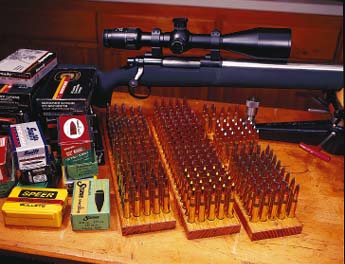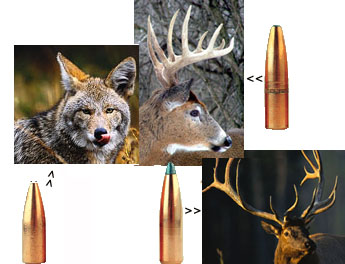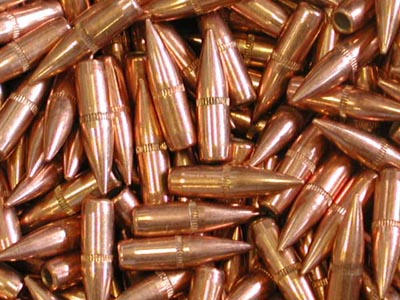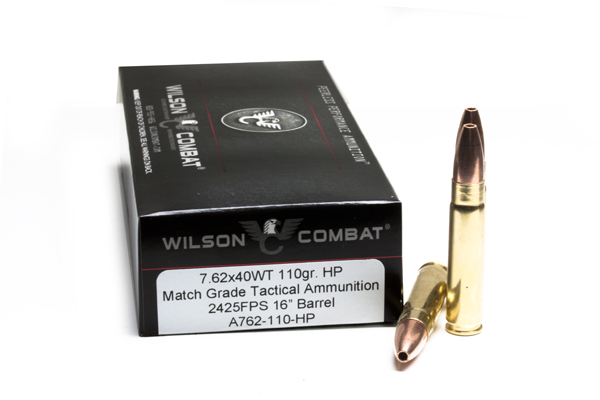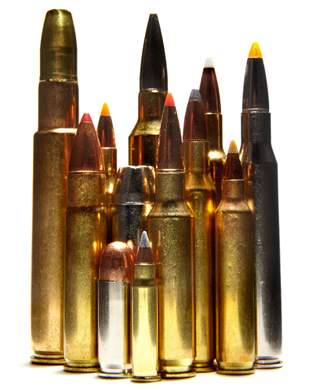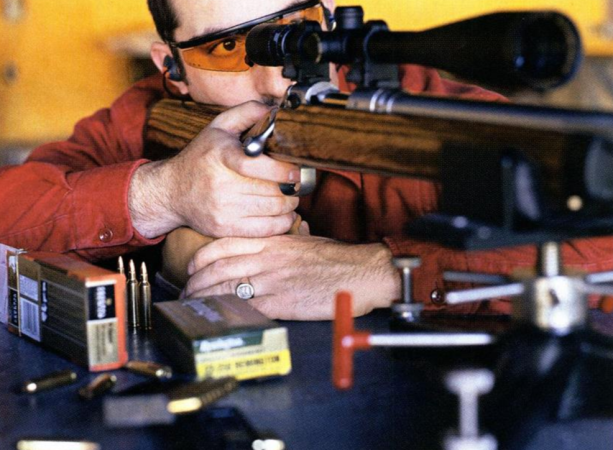We may earn revenue from the products available on this page and participate in affiliate programs. Learn More ›
Less is more” has seldom been a compelling motive in the making and selling of ammunition. But that is exactly the direction Remington is taking with its new Managed Recoil line of centerfire rifle cartridges. As the name implies, Managed Recoil ammo, which currently comes in .270 Winchester, .30/06 and 7mm Remington Magnum (with more calibers presumably to follow if it will make shooters happy), kicks less than standard loads in the same calibers–a lot less.
This sounds like a great idea. The only souls I can think of who claim to enjoy recoil probably also get their kicks from walking barefoot on broken glass. But first, what magic has Remington wrought to reduce the kick of these three popular calibers? In order to get a clear understanding, let’s take a lesson in basic physics.
A few hundred years ago a smart Englishman by the name of Isaac Newton spent a lot of time worrying about why apples fall and why other things happen the way they do on our planet. (As I recall, he never married, which explains why he had extra time on his hands.) After giving these matters a lot of thought, Newton came up with answers known as his “laws of motion.” His third law states that for every action there is an equal and opposite reaction, which takes us to the heart of why guns kick the way they do.
HOW RECOIL WORKS
In simplest terms, the force that drives a bullet or shot charge forward also drives the firearm rearward. Of course, the firearm doesn’t charge to the rear with a velocity anything near that of the bullet flying out the muzzle, but that’s simply because the firearm is many times heavier than the bullet or shot charge. If, in fact, the gun and projectile were of equal weight, they would depart from each other in opposite directions at equal velocities. (Don’t try this!) By the way, Newton put a lot of effort into studying the flight of bullets, which plainly tells us he was our kind of guy.
So now, applying Newton’s third law of motion to the matter at hand–reduced recoil–we quickly understand that there are a couple of different ways to make a gun kick less: One is to reduce the weight of the projectile. This is why a 1 1/8-ounce load of shot from your shotgun kicks less than a 1 1/2-ounce load. The other way is to reduce the force that drives the shot charge or bullet. Problem is, when force is reduced there is a corresponding drop in velocity.
Whoa now! Shooters who drink their velocities and trajectories straight don’t take kindly to watered-down ballistics, no matter what fancy name you call it by. Be this as it may, the heavy thinkers at Remington are of a mind that folks will enjoy shooting more if their heavy-hitting rifles are less painful to shoot, and will therefore shoot more rounds and more often than they would otherwise. According to this logic, youngsters will take to bigger calibers at an earlier age and become better marksmen and hunters for it.
Remington takes a two-pronged approach to reducing recoil by reducing velocity and using bullets that are lighter than those typically used in these calibers, as you can see here:
STANDARD MANAGED BULLET RECOIL RECOIL CALIBER WEIGHT VELOCITY VELOCITY
.270 Win. 115 gr. not available 2,710 fps .30/06 125 gr. 3,140 fps 2,660 fps 7mm Rem. Mag. 140 gr. 3,170 fps 2,710 fps
To get a handle on what these numbers mean in terms of recoil, here’s a comparison of how hard a 7 1/2-pound rifle would kick, in foot-pounds of recoil energy, in each of the three calibers. These recoil calculations have taken into account the approximate weight of the propellant charge as well as bullet weight, which, depending on caliber, ranges from 40 to 70 grains.
STANDARD MANAGED CALIBER AMMO RECOIL
.270 Win. 16.5 ft.-lb.* 10.7 ft.-lb. .30/06 16.9 ft.-lb. 11.6 ft.-lb. 7mm Rem. Mag. 22.2 ft.-lb. 16.2 ft.-lb.
* For a 130-grain bullet, as there are no comparable loadings for 115-grain in .270 Win.
About now I can almost hear old-time handloaders saying, “So what’s the big deal here? We’ve always loaded down and used lighter bullets for soft-kicking practice loads. Why does Remington think it’s done anything new?” Actually, Remington has done something new and deserves a big heap of credit for recognizing and solving problems that seldom occur to reloading buffs. For lack of a better name, I call this the “take-a-guess” factor because there are so many exceptions.
REDUCING THE GUESSWORK
Several years ago I ran across a hunter whose life’s mission seemed to be condemning ammo made by major arms manufacturers. The icon of his crusade was a single bullet he claimed to have found superficially embedded in an elk’s hindquarter. Except for the engravings left by passage through a rifled barrel, the bullet looked almost new and was easily identifiable by maker and type. Clearly the bullet had hit the elk at the end of its trajectory, with just enough remaining velocity to penetrate the hide, where it had remained, possibly for years. The only remarkable thing I could see about the bullet was that it had actually connected with the target at what must have been many hundreds of yards. The crusader, however, didn’t see it that way at all, but rather chose to see it as a shining example of a bad bullet made by a bum company. And that is almost exactly the scenario faced by Remington when it set forth to develop its Managed Recoil line.
Ammunition manufacturers struggle valiantly to make bullets that stay together and expand prettily at the widest possible range of impact speeds, but even so it’s an open-ended guess (the take-a-guess factor) exactly how far and at what velocity a bullet will meet its destiny. This is why ammo makers design bullets to expand best within a certain–make that uncertain–velocity zone.
When you drop below that velocity zone, bullet expansion becomes unreliable. In some cases, as with the bullet found in the elk, there is no expansion at all. To be more specific, take the 140-grain bullets loaded by Remington in its standard 7mm Rem. Mag. ammo. These bullets are designed for optimum expansion at a range somewhere between 75 and 200 yards (the take-a-guess factor again), when velocity has dropped to somewhere between 2,700 and 2,800 fps. With the Managed Recoil 7mm Rem. Mag. load, velocity will be roughly 400 fps less at those ranges. In other words, a bullet designed for best expansion at 2,700 fps will possibly expand poorly–or not at all–at 2,300 fps.
So Remington went back to the drawing board and engineered entirely new Core-Lokt bullets to expand best at Managed Recoil velocities, and did considerable field testing to fine-tune the new designs. The bottom line of Managed Recoil performance on deer-sized game is: Keep your shots inside 200 yards and the animal won’t know the difference. For longer shots, the old-fashioned, full-house loads are still your best bet. Which, by the way, brings up the differences in trajectory and point of impact of Managed Recoil cartridges.
It’s no secret that fast bullets have flat trajectories, which is a main reason the flat-shooting .270 and 7mm Rem. Mag. are so popular with hunters. Obviously, the reduced velocity of Remington’s Managed Recoil ammo means they do not shoot as flat as standard ammo in the same calibers with bullets of corresponding weight. But by how much? A computer-generated comparison of Managed Recoil vs. standard 140-grain loads in 7mm Rem. Mag. gives us these estimates when both loads are sighted in to hit dead-on at 100 yards:
RANGE 50 100 150 200 250 300 (Yd.)
M.R. -.1 0 -1.3 -4.2 -8.7 -15.1 Std. -.3 0 -.7 -2.6 -5.6 -10.0
If you’re sighted in with 130-grain bullets in your .270, the comparison looks like this:
RANGE 50 100 150 200 250 300 (Yd.)
M.R. -.1 0 -1.4 -4.5 -9.5 -16.7 Std. -.2 0 -.9 -3. -6.5 -11.6
Obviously, out to 200 yards the differences in trajectories aren’t enough to worry about for practical hunting purposes. But that doesn’t mean you can do your sighting-in and practicing with Managed Recoil ammo and then blithely go hunting with full-power loads. A couple of other factors creep in and complicate matters.
WATCH FOR SHIFTS
Rifles tend to have minds of their own as to where they send their bullets and often are perversely unpredictable. Barrel flip, torque and the way we individually hold and aim our rifles (not to mention evil elves) conspire to change the point of impact–sometimes radically–when we change from one ammo to another. This zero shift is especially likely when changing bullet weight or with ammo having different velocity levels. Not only can point of aim shift vertically; it can move horizontally as well. There’s even a good illustration of this in Remington’s 2004 catalog, which honestly shows a horizontal shift of about an inch between Managed Recoil and standard .30/06 ammunition.
So if you plan to practice with one and hunt with the other, be sure to check the point of impact of both. With a bit of luck they will be so close that you won’t need to change your scope settings. But don’t bet on it.
In my opinion, Managed Recoil ammo is a noble experiment and I hope it does well. Any effort that makes shooting easier and more fun, especially for youngsters, will be of long-term benefit to all of our shooting sports. But will it succeed in the marketplace? Check back in about a year; if other ammo makers are also offering reduced-recoil rifle ammo, we will know that less can be more.
Low-Recoil Advantages
Remington’s Managed Recoil .30/06 load (left) features a newly engineered, 125-grain Core-Lokt bullet that’s designed to expand best at low-recoil velocities. For shots out to 200 yards, your deer is never going to notice the difference, but for longer shots, you’ll be better off sticking with standard-velocity loads (right).
Managed Recoil ammunition is perfect for those wishing to spend more time practicing with their hunting rifles without getting knocked around.
Just Jim
Young Guns
Back when I was a boy, I hitchhiked to school and just about everywhere else. Young guys thumbing rides were common in those days, and usually the first car that came by would give me a lift.
Quite often I was carrying a gun when I was hitchhiking–not for protection but just to show to someone wherever it was I was going. Everyone liked guns back then and when I caught a ride it gave the driver and me something to talk about for a few miles.
It’s been a long time since I’ve seen a hitchhiker with a gun over his shoulder. How sad it is that times have changed.
Editor’s Note: It turns out that other ammunition manufacturers are responding to the low-recoil concept even sooner than Carmichel predicted.
Federal Cartridge Company (ATK) has announced “Power-Shok” reduced-recoil loads in .308 Win and .30/06. Both calibers are being loaded to a muzzle velocity of 2,000 fps with a 170-grain, flat-tipped Speer bullet that expands well at reduced velocity levels. The folks at Federal say the new Power-Shok loads function in autoloaders and are effective on medium-size game out to 200 yards.

